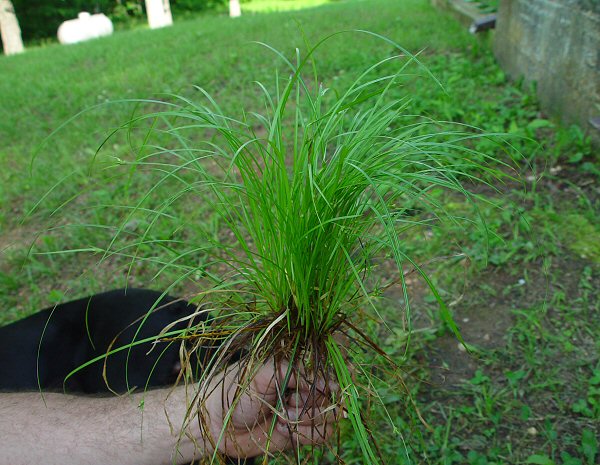Carex jamesii Schwein.
Grass Sedge

Native
CC = 4
CW = 5
MOC = 92
© DETenaglia
Carex jamesii Schwein.Grass Sedge | |
 |
Native CC = 4 CW = 5 MOC = 92 |
© DETenaglia |
|
Family - Cyperaceae Habit - Monoecious sedge, lacking rhizomes and forming dense clumps.
Stems - Flowering stems 5-30 cm long, sharply trigonous, roughened on the angles near the tip, glabrous, light brown at the base. Vegetative stems present, leafy, composed nearly entirely of a series of overlapping leaf sheaths. Leaves - Basal or nearly so, longer than the flowering stems, glabrous. Blades 1-35 cm long, 2-3 mm wide, flat. sheaths with the tip truncate to slightly convex, the ventral surface thin, green to white, the ligule wider than long and U-shaped, the lowermost sheath bases light brown.
Inflorescences - Inflorescences with 1-3 spikes, the uppermost terminal, the others basal or nearly so, on long, slender stalks, the inflorescence lacking bracts except for the bractlike, pistillate scales.
Spikes - Spikes all alike, staminate toward the tip and pistillate toward the base. Staminate portion of the spikes 2-10 mm long, linear, with 4-20 flowers, the scales oblong-obovate, wrapped around the axis, truncate and uneven at the tip, brown with a light green base and a tan upper margin. Pistillate portion of the spikes with 2-4 perigynia, the lowermost 1 or 2 scales 15-50 mm long and leaflike, the uppermost reduced, white-margined, and sometimes awned.
Perigynia - Perigynia 5-6 mm long, the main body 2.4-2.7 mm long, 2.2-2.5 mm wide, circular to broadly elliptic-obovate in outline, tapered abruptly at the tip into a more or less trigonous beak as long as or somewhat longer than the main body, green, glabrous. Styles withering during fruit development, jointed to the main body of the fruit, which is not beaked at maturity. Stigmas 3. Fruits 2.4-2.7 mm long, circular to elliptic-obovate in outline, circular to obscurely trigonous in cross-section, dark brown to nearly black.
Flowering - April - June. Habitat - Bottomland and mesic forests, ledges and bases of mostly dolomite bluffs. Origin - Native to the U.S. Other info. - This small Carex species is one of the easier sedges to identify. In the field the plant is very common in mesic bottoms and often covers the forest floor. The thin, shiny green leaves can be seen in large clumps. The spikes contain only a very few perigynia, and these are abruptly beaked. The plant occurs throughout Missouri, and has a range which extends from eastern Oklahoma through parts of New England. Photographs taken in the Ozark Scenic Riverways, Shannon County, MO., 5-19-03 (DETenaglia); also at Danville Conservation Area, Montgomery County, MO, 5-6-2017, and Northwest Sports complex, Jefferson County, MO, 5-10-2021 (SRTurner). |